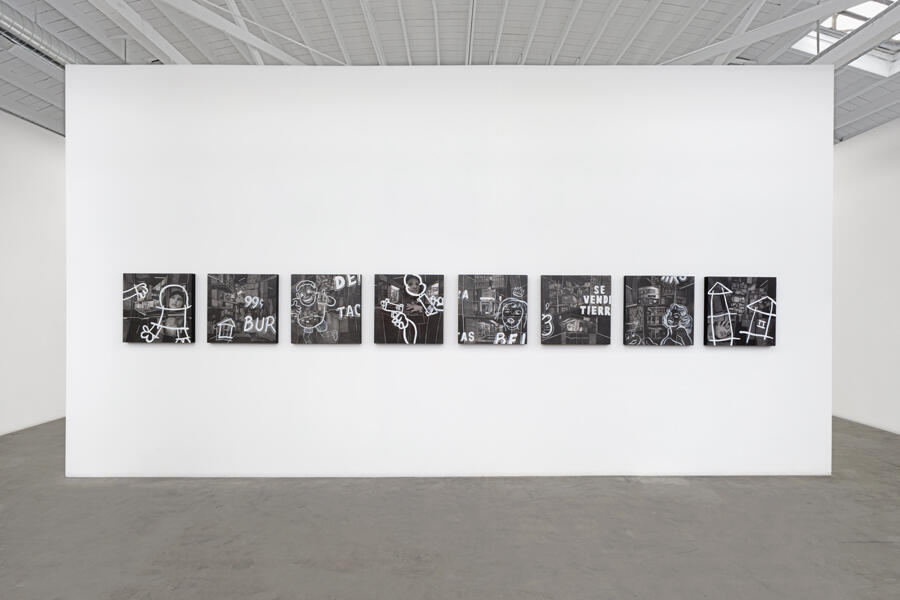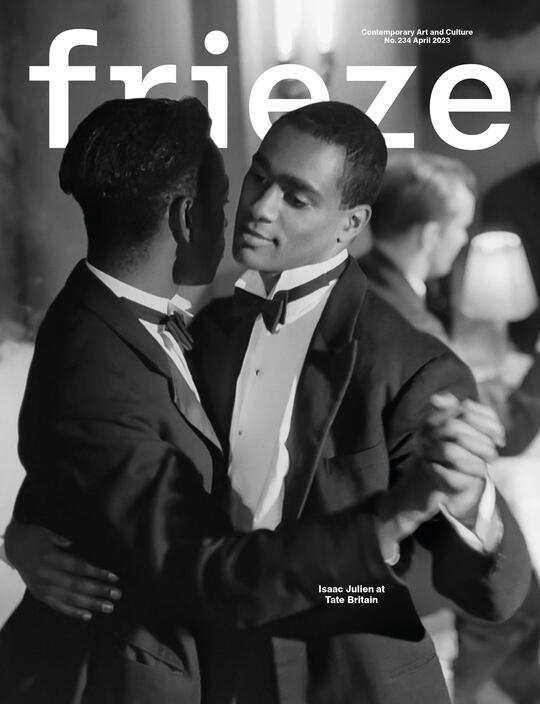Hugo Crosthwaite Animates Disillusion and Resilience at the US-Mexico Border
At Luis De Jesus, Los Angeles, the artist displays figurines, paintings and animations that draw on the physical, psychological and cultural landscapes of borderlands
At Luis De Jesus, Los Angeles, the artist displays figurines, paintings and animations that draw on the physical, psychological and cultural landscapes of borderlands

Conceptually positioned in the borderlands between the United States and Mexico, ‘Hugo Crosthwaite: Caravan’ at Luis De Jesus deploys the languages of artistic and popular media to portray both the perils of the border and the humanity of those who must traverse it. Upon plywood pedestals, hand-painted ceramic figurines, made to resemble ancient Mayan idols, represent the many migrants traveling in caravans with whom Crosthwaite has interacted for over 20 years (‘Caravan Group’, 2022). At the centre of each five-sculpture grouping, however, is a figure with no face but only a painted skull – a stark reminder of the many lives claimed by the border.

Crosthwaite was born in Tijuana and raised in coastal Rosarito, Baja California, Mexico. His United States citizenship allows for privileged yet intimate encounters with the many migrants who pass through the region, granting the artist a sensitivity to the reality of border crossings not always shared by his national compatriots. This sensitivity is especially evident in his ‘Borderlands’ paintings, vivid and immediate, in dark pencil and charcoal. Caravan (2022), a stop-motion animation partly incorporating the paintings and figurines, tells the compelling story of a man whose life in Tijuana flashes before his eyes in the enclosed caravan. He comes to his senses and draws on the collective power of his fellow migrants as they march forward in their path towards the United States.

The greyscale ‘Borderlands’ series captures the desolate, almost dystopic architecture of Tijuana street scenes, overlayed with images drawn from American pop culture. Guns, pin-ups and caricatures of Anglo-Americans allude to a tarnished American Dream. Borderlands No.4 (2022) features a near-complete ‘Se Vende Tierra’ (Land for Sale) slogan – invoking migrant remittances used to buy land ‘back home’, but also nodding towards the land purchased by American corporations after the North American Free Trade Agreement (NAFTA) took effect in 1994. The agreement eliminated most tariffs imposed on trade between the two countries, expediting the export of factory production, creating a dangerous ecosystem of exploitative labour practices, waste dumping and increased violence against the majority-women workforce of the so-called maquiladoras.

These are the narratives that have storied Tijuana’s recent history and – to a degree – the borderlands at large. Crosthwaite carefully captures these realities in his ‘Manifest Destiny' series, the artist’s first paintings in colour in nearly 20 years. With a palette of orange, red and blue hues, Crosthwaite fuses migrant portraits with icons of American culture and comic book idioms to create playfully haunting images. In Manifest Destiny (2023), the largest of the set, graphic linework mimicking the texture of linocuts creates an arresting scene of mothers carrying their children through a sea of vicious cacti. Lady Liberty’s torch glimmers in the background, reminding viewers of the hope and resilience required for such a treacherous journey.

The Virgin of Guadalupe, captured nearby in Manifest Destiny (Guadaloupana) (2023), stands in as an icon of Mexican cultural heritage and popular culture. Her overlay atop an oblique reference to the Mexican coat of arms – which alludes to the nation’s founding story in Tenochtitlan – collapses histories to speak to the root cause of migration in the western hemisphere: colonial relationships that underpin the system of global capitalism we are so familiar with today. Interwoven with these complex histories are the faces, feelings and stories of those who endure the violent legacies of imperialism. Crosthwaite effectively generates a deeply empathetic body of work that kindles a faint flame of hope in a dark landscape.
‘Hugo Crosthwaite: Caravan’ is on view at Luis De Jesus, Los Angeles, until 4 March.
Main image: Hugo Crosthwaite, from the ‘Borderlands’ series, 2023, pencil, charcoal, and acrylic paint on mounted board on panel, each 61 × 61 cm. Courtesy: the artist and Luis De Jesus Los Angeles
























